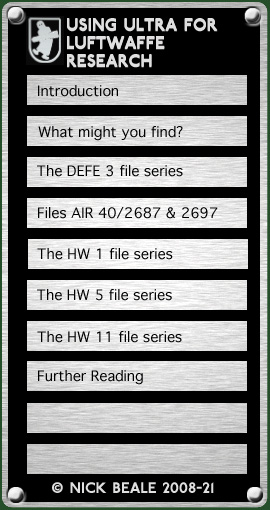|
This series includes a number of bound volumes dealing with particular periods and theatres of war under the overall title “GC&CS Air and Military History.” Other volumes cover the naval side of Bletchley Park’s work but I have not looked at any of these. What follows is all based on a fairly brief look at one file, HW 11/5 “Vol. 5, Italy 1943-45.” This was compiled in 1945 and early 1946 by a six-strong team which included one American officer. It was then edited by Commander Alexander Mackenzie of BP’s Naval Section. The compilers are described as “intelligence officers in the Sigint Centre who had been responsible during the war for the handling and dissemination of decrypts of German high-grade cyphers (relating to the German Army and Air Force) only.” Italian Air Force cyphers were handled by a different section and form the basis of Volume XII (which I haven't looked at yet). While the principal source seems to have been deciphered messages, some other intelligence estimates, reports, captured material, prisoner of war reports and supporting documents are also cited. This extract (from pages 171–2) concerns Luftwaffe redeployments in Italy in 1943, in the wake of the evacuation of Sicily: On 2nd August, I., II. and III./JG 53 were given Vicenza as base station; I. and II./JG 77 and IV./JG 3 were given Treviso, “in order to carry out the most thorough-going dispersal”(4). On 7th August came the first mention of the mortar(5) Staffel of IV./JG 3 as such, although twenty Me 109’s with 21-centimetre mortars destined for IV./JG 3 had already been reported(1). Fliegerkorps II operational orders for 12th August included the carrying out of a special task by an unknown unit, to which JG 3 was to be subordinated. It was pointed out by GC&CS in a note to the decrypt that the operation might involve the use of mortar ammunition(2). The figures in brackets refer to footnotes. Three of these give the serial numbers of the decrypts on which the text is based; footnote (5) however reads as follows: A current Air Ministry appreciation (AIX 491) estimated that this referred to aircraft equipped with 21-centimetre rocket-propelled mortar bombs as used by German smoke batteries in Africa, except that a high explosive charge would be substituted for the smoke. It was thought that they could be used in the air. This turned out to be substantially correct. These mortar aircraft were in fact a considerable thorn in the flesh of the Allies and were responsible for very heavy losses in bomber formations. However, the extra weight of the mortars tended the fighters thus equipped relatively slow and unmanoeuvrable, with the result that, when the Allies were eventually able to give their bombers long-range fighter escort, the losses suffered by mortar aircraft became prohibitive. Another example (pages 179–180): Several bomber attacks were made on the North African and Sicilian harbours, as well as on shipping off Sicily(5). Special Intelligence usually gave some warning that these were to take place, and specified the forces operating, but, as the German Air Force at this point again adopted the practice of using cover names for targets, that actual targets of the attack were frequently not apparent in time(1). One exception was an attack ordered for 29th–30th August, which was to be called Operation “Donnerschlag” [Thunderclap] (2). Comparison with previous orders for “Donnerschlag” on 28th–29th August enabled GC&CS to suggest that this undertaking might be an attack on Bizerta(3). The footnotes in this case all refer to decrypts (none of which I've read): (5) CX/MSS/3078/T17, 3090/T17. (1) CX/MSS/3132/T38, 48; 3141/T26, 31. (2) CX/MSS/3132/T60. (3) CX/MSS/3130/T24. From the above, I’d infer that the Official Histories should offer a useful picture of what might be found in Ultra at a given point in a campaign including a fairly comprehensive picture of Luftwaffe and Heer dispositions for the relevant theatre and time. continued on next page …
|
|||

